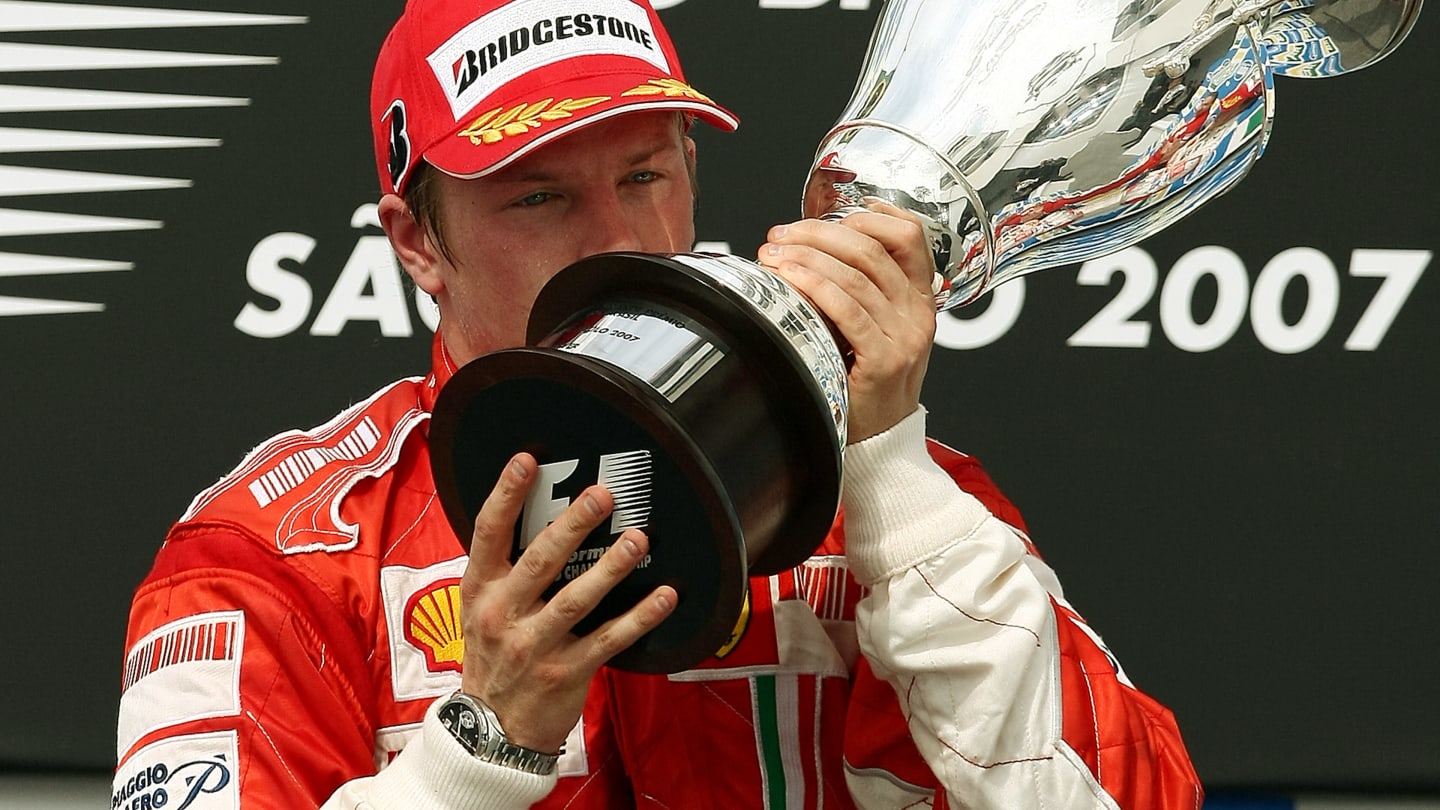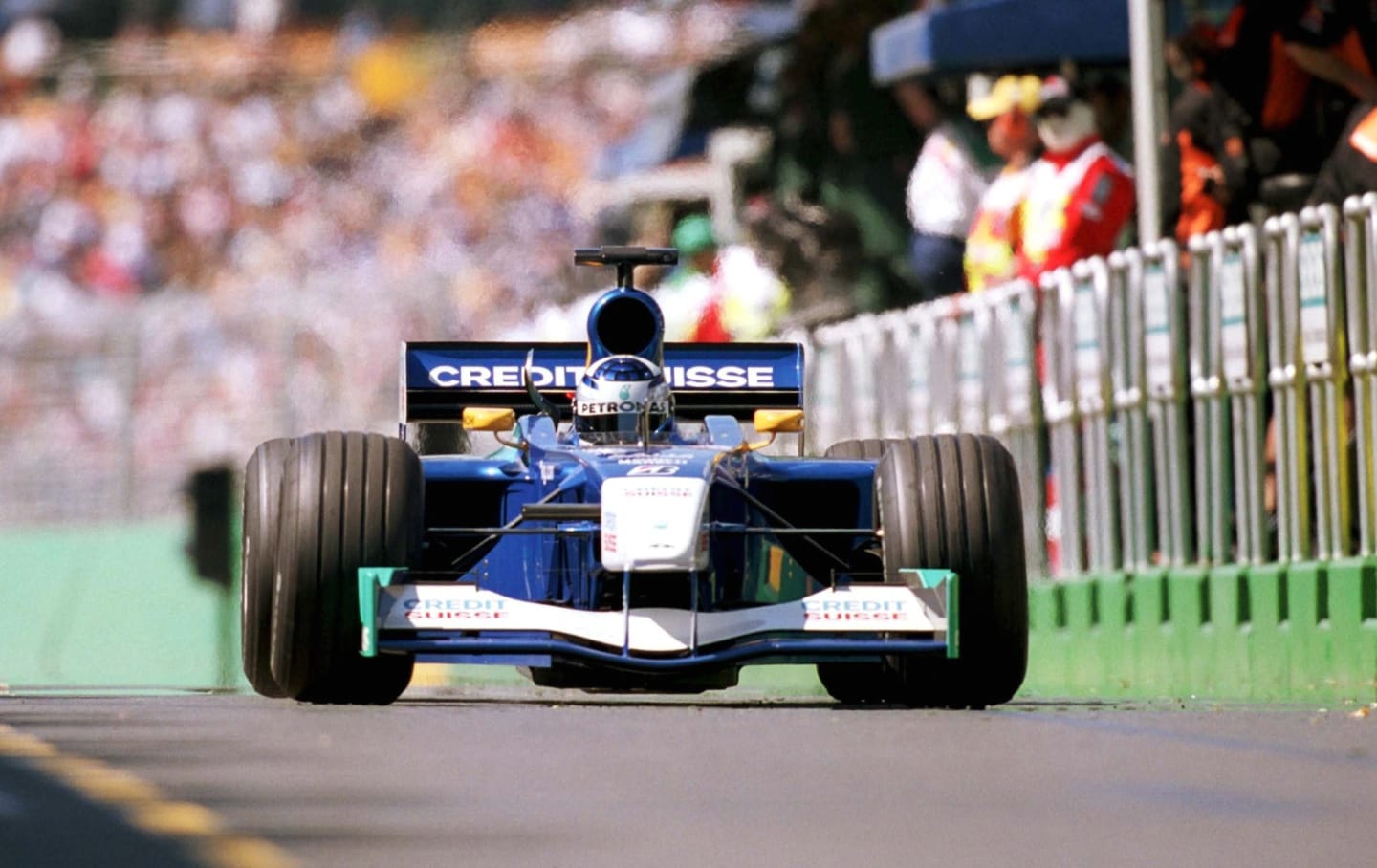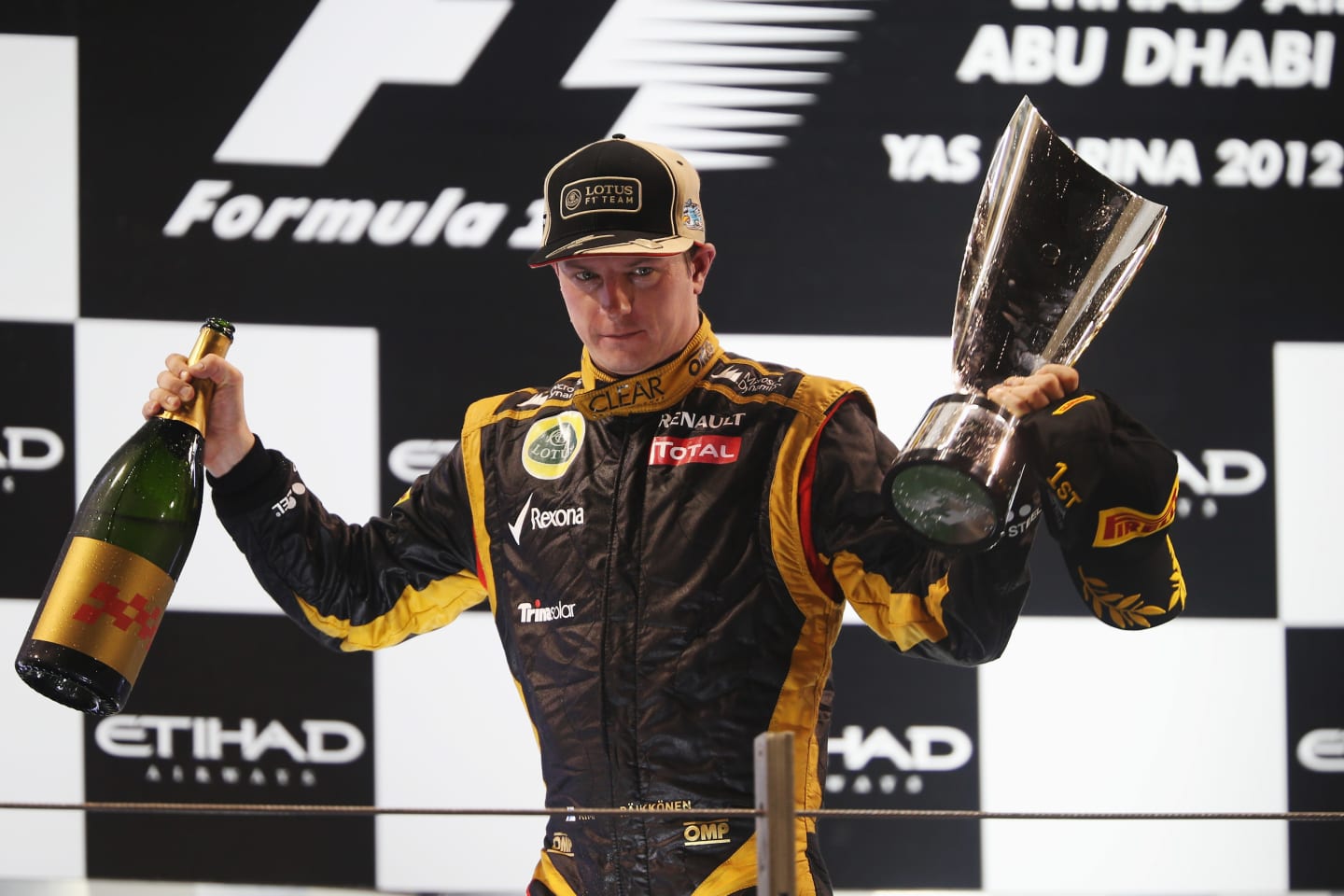
HALL OF FAME - 2007
Kimi Raikkonen

Fast-tracked into the sport with the shortest CV on four wheels, the unknown newcomer who came from nowhere and said next to nothing immediately proved he knew exactly what he was doing: driving a Formula 1 car as fast as it could possibly go. The car couldn't always keep up with his talent and it took seven seasons for Kimi 'Iceman' Raikkonen to become World Champion. Notoriously inanimate and uncommunicative, the silent speedster's frozen expression in fact masked the hidden depths in one of the most original - and popular - characters in the sport's history...
Kimi Matias Raikkonen spent his childhood in a house built by his great grandfather in Espoo, a suburb of the Finnish capital, Helsinki. To provide for Kimi, born on 17 October, 1979, and his older brother Rami, their hard-working parents Matti and Paula toiled, respectively, as a road builder and an office clerk.
Money was scarce but the Raikkonens were a happy family and their humble homestead surrounded by open countryside was an ideal environment for the two rambunctious youngsters to flex their racing muscles. At first (when Kimi was just three years old) the brothers tore around on miniature motocross bikes fitted with training wheels. A move to karts paved the way for Kimi (who began competitive karting at 10) and Rami (who eventually became a successful rally driver) to make rapid progress in motorsport, though it came at a cost. Matti had to work nights as a taxi driver and nightclub bouncer and funds diverted to karting meant plans to replace the outside lavatory with a proper bathroom in the family home had to be postponed.

Raikkonen during his debut season with Sauber at the 2001 Australian Grand Prix
Kimi, a reluctant student who used his schoolbag as a sled to slide down snow-covered hills, enjoyed winter sports, especially ice hockey, though he eventually gave it up because he hated getting up for early-morning practice. At 16 he left school and enrolled in a course for mechanics, believing this skill might be the only way to stay involved in motorsport. Very soon his mechanical expertise, and the need for family funding, became superfluous, as Kimi's natural talent for driving fast led to sponsored rides.
Following a rapid series of successes in Finnish, Nordic and European karting, he jumped into a racing car and promptly won two British-based Formula Renault championships. In the fall of 2000, despite having just 23 car races to his name, he was given a test by the Sauber Formula One team. Impressed by his immediate pace and assured approach, Sauber shrewdly signed the 21-year old to drive for them in 2001. His having short-circuited the conventional route to the top provoked fierce debate over his right, let alone his readiness, to race at the pinnacle of motorsport. Raikkonen rapidly silenced his critics (he finished sixth in his Grand Prix debut) and attracted the attention of McLaren, who saw him as a likely successor to the retiring two-time champion, Mika Hakkinen.
One Finn after another proved to be a good thing for McLaren, for whom Kimi the 'Iceman' never gave less than his maximum, always driving to a personal limit that at least equalled, sometimes exceeded, the best of his peers. Experts endlessly praised his seamless, straightforward, mostly mistake-free style. "I never really think about what I'm doing," Kimi said in a rare outburst of self-analysis. "I just do it."
His five seasons at McLaren coincided with a period of unevenly performing, often unreliable, cars. Yet he finished second in the championship twice (2003 and 2005), won nine races and finished in the top three on 36 occasions. His podium appearances and subsequent TV interviews exposed him to public scrutiny under which he tended to squirm and fidget, tugging his ears, rubbing his nose and trying to hide beneath his baseball cap. He seldom smiled, spoke sparingly in a mumbled monotone, then all but ran for the nearest exit.
Yet in his private life the poker-faced enigma's icy reserve was prone to spectacular bouts of thawing out. 'Drunken Race Ace Kimi Bounced Out Of Lapdance Club For Fiddling With His Gearstick!' shrieked a headline in a British tabloid newspaper. Spanish media gleefully reported that the vodka-loving Flying Finn was found lying fast asleep outside a bar embracing an inflatable rubber dolphin. In Monaco he was filmed cavorting on a yacht, swaying unsteadily on the upper deck then falling onto on a lower level where he landed on his head.
"What I do in my private life doesn't make me drive any slower," the free-spirited speedster insisted. In truth, the Iceman's private life was running smoothly and he was well-settled on the domestic front, having in 2004 married Jenni Dahlmann, a gorgeous Finnish fashion model and former Miss Scandanavia. At their sumptuous Swiss home there was plenty of room for their two dogs and Kimi's car collection. Asked to name his most prized possessions, he replied: "My wife and my Ferrari Enzo."
In 2007 he began driving a Ferrari Formula One car for a living, having been hired (for a reported $41 million a year) to fill the considerable void left by the departing seven-time World Champion Michael Schumacher, whose unrivalled work ethic and team leadership qualities were not part of a Raikkonen repertoire that seemed more akin to another past champion. A week before his debut with the team, Ferrari's new recruit was in Finland, winning a dangerous snowmobile race he had entered under the alias of 'James Hunt.' When the same 'James Hunt' later competed in a powerboat race dressed in a gorilla suit Kimi said he invoked the name of his hero as a riposte to the media sensationalisation of his private life.
He got off to a fast start with Ferrari, winning the season-opener from pole position, though by the penultimate race he was third in the driver standings, behind the McLaren team mates Fernando Alonso, seeking a third successive title, and Lewis Hamilton, the record-breaking rookie. Though Raikkonen had won more races, five to their four apiece, he remained the longshot among the trio of contenders at the final race, in Brazil. The phlegmatic Finn delivered sensationally, winning the race and the 2007 World Drivers' Championship by a single point.
On the podium the new champion swigged and sprayed his champagne and, grinning at last, the Iceman broke his silence with a virtual torrent of words. "I'm very happy. I came from pretty much nothing but my family, friends and sponsors helped me get here. People will probably look at me differently and make up more stories about me. But I'm going to lead my life as I want and that's it."

Raikkonen at the wheel of the McLaren MP4-17D in practice for the 2003 Malaysian Grand Prix in Kuala Lumpur
And so he did. In two more seasons with Ferrari his results tapered off, as did his interest in continuing. At the end of 2009 Ferrari offered him a lucrative way out by buying up the final year of his contract (to make way for Fernando Alonso). Kimi spent the next two seasons amusing himself in the World Rally Championship, an experience he found no substitute for competing at the pinnacle of motorsport, where he returned in 2012 to drive for the Lotus F1 Team.
His comeback was a resounding success. He finished a remarkable third overall in the championship and led Lotus to a highly respectable fourth in the team standings. He was the only driver to complete all 20 races, one of which he won memorably. En route to his popular victory in Abu Dhabi the entertainingly enigmatic Iceman became irritated by ever more anxious radio instructions from his increasingly frantic race engineer. Kimi silenced the voice in his ear with a phrase that immediately entered Formula One folklore: "Leave me alone. I know what I'm doing."
Kimi continued to know what he was doing, winning the first race of 2013, coming second in six others and collecting enough points to finish fifth among the drivers, despite missing the last two races to have an operation to repair a back injury. Then, in keeping with his tradition of independence, he announced he was leaving Lotus and would in 2014 return to the team where he won the 2007 championship: Ferrari.
His return to the Scuderia was a disaster, prompting speculation that the Iceman had finally melted. Humiliated by his team mate Fernando Alonso, who scored three times as many points, Raikkonen blamed his worst ever results on an inability to change his car’s handling to suit his driving style. The phlegmatic Finn handled the setback philosophically - “It doesn’t matter. It is what it is.” – an opinion that was shared by Ferrari, who retained his services for 2015.
‘Lacklustre’ and ‘underwhelming’ were some of the terms critics used to describe a 2015 season that seldom went smoothly for Kimi Raikkonen. There were more incidents and accidents than usual and he finished a distant fourth in the championship, well behind his new team mate Sebastian Vettel. Yet he remained arguably the most popular driver and Ferrari renewed his contract. “It’s not been an ideal year,” Kimi admitted. “That’s how it goes.”

Raikkonen heads Ferrari team mate Fernando Alonso during the 2014 Spanish Grand Prix
A resurgent Raikkonen - rejuvenated by a contract extension for 2017 and remaining relaxed amid the chaos that unsettled his team mate Vettel - was often Ferrari’s main threat in 2016.
And in 2017 - fourteen years after he made his F1 debut, and nearly a decade since he won the driving title - Kimi Raikkonen continued to be a fixture in the sport. No longer a race winner, but dutifully performing his role as understudy to his team leader Sebastian Vettel, he finished fourth in the 2017 driver standings and scored a fair share of the points that enabled Ferrari to secure second place among the teams. For his contribution the Faithful Finn was given another contract extension for a further year.
Kimi Raikkonen finished a solid third overall in the 2018 Drivers’ Championship, racing reliably, scoring points regularly (including 12 podiums and a 21st career win at the US GP) and remaining a bright spot in an otherwise frustrating year for Ferrari, for whom his 2007 driving title made him the famous team’s last World Champion. His uncomplicated character provided a valuable steadying influence during the periods of disarray that again plagued Ferrari. He enjoyed continuing popularity with the fans, among them Sebastian Vettel, who declared Kimi his best ever team mate.
Kimi-watchers saw his traditionally inanimate demeanour enlivened by frequent smiles. The offbeat oddball celebrated for his silence even spoke more. He was a happy man and it showed. Having sorted out his sometimes turbulent private life he now relished his role as the head of a charming family: wife Minttu, young son Robin and baby daughter Rianna.
But he still loved his racing. At the age of 39 and a multimillionaire the veteran of 294 Grands Prix could easily have retired to his sumptuous estates in Switzerland and Finland. Instead, he signed a two-year contract with Alfa Romeo Racing – formerly Sauber – in a back-to-the-future return to where his great F1 adventure began.
From 2019 the newly-renamed team was comfortably led by the sport’s oldest driver. Kimi, who turned 40 in October of that year, proved his motivation was undiminished by earning 43 of the Swiss squad’s 57 points, emphatically outscoring team mate Antonio Giovinazzi – 15 years younger than the 'elderly' Iceman.
Toiling in the relative obscurity of the eighth-placed Swiss-based team suited the publicity-shy Finn well. Living nearby enabled him to frequent the factory where his presence helped inspire the personnel and contribute to the car’s development. Moreover, the more mature Kimi Raikkonen, once notorious as a rowdy tearaway but now a devoted family man, was finding his private life especially rewarding.

Raikkonen celebrates on the podium after winning the 2012 Abu Dhabi Grand Prix with Lotus
In 2021 Raikkonen finally decided that those rewards outweighed the racing ones, and after a record 349 starts as an F1 driver, the 42-year-old veteran retired from the sport. In his last season, though forced to sit out two races after testing positive for Covid-19, he scored 10 of his Alfa Romeo Racing team’s 13 points. In a career spanning nearly half his lifetime and driving for five different teams he scored 21 wins, 103 podiums, 18 poles, 46 fastest laps and a world championship in 2007.
Where he made even more of a mark was in the popularity department, with F1 fans and, uniquely, the drivers. Among those paying tribute to the so-called ‘Iceman’ were three still active world champions.
Lewis Hamilton: “I remember before I got to Formula 1 in computer games I’d always be in Kimi’s car. So I had this crazy experience of racing against him, losing a championship to him and then having lots of great battles with him. He will be missed.”
Fernando Alonso: “I like him a lot. In his own way he loves the sport. He is very honest always. I really like that part of him. And outside when he takes his mask off from being a cold Iceman there is a very good person inside. He has been outstanding for the sport and he will be missed because he has his own character and he was different.”
Sebastian Vettel: "Great respect. I don't think you can have an argument or a problem with Kimi. If you do, then the problem is not him, the problem is you. He's a great person, and I'm sure we'll stay in touch. I wish him all the best and I will miss the silence."
In his last race his Alfa Romeo car bore a farewell message from the team: ‘Dear Kimi: We will leave you alone now.’ Even though a mechanical problem meant he failed to finish, appreciative F1 fans from around the world voted him ‘Driver Of The Day.’
In the end Kimi was moved to say a few words: “I feel good. I’m happy I lived through it. Now I look forward to living a normal life.”
Text - Gerald Donaldson